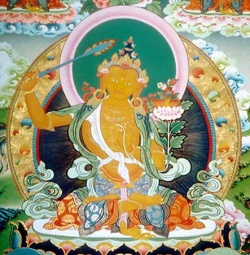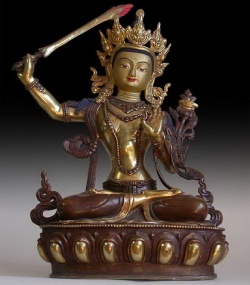The Buddhist Heavens
The Buddha was silent about the existence of God. He said to have denied any first cause or the Cause of the Causes as the source of all creation. Creation, according to early Buddhism, is an ongoing and ever continuous process, which is without a beginning and without an end.
All the things that exist in all the worlds are subject to infinite changes. They are becoming continuously, becoming from something into another thing. They pass from state of existence into another, go from one set of conditions to another. This process is continuous and natural to the beings who are subject to change and impermanence. It goes on till a being is full liberated through attainment of Nirvana. Becoming is thus the inexorable law and the fundamental Truth of our existence.
The Buddha denied the existence of God. But he confirmed the existence of other worlds, of heavens and hells populated by celestial beings, some of whom even bore the name of Hindu gods. In the early Buddhist literature, the Buddha himself was described as having gone to the heavens and meeting with the gods. The scriptures also quoted instances of gods descending down to the earth to witness some momentous events in the life of the Buddha.
Prominent among the Buddhist gods are Sakka and Brahma. Sakka is like the Indra of the Buddhist pantheon. He is the ruler of gods and stays in the world of desires. Brahma is the overlord of the highest heavens, the Brahma lokas. He is is mentioned frequently in the Buddhist scriptures. In Buddhism he becomes a follower of the Buddha, as if he has become converted to Buddhism by the Buddha himself.
The gods are not immortal, though they may live longer than the earthly beings. They also are subject to decay and change, and the process of becoming. The intensity and the manner in which these processes take place however may be different and involve longer periods of time. But like any other beings, they are with a beginning and an end.
They are inferior in status to the Arhats who have attained Nirvana. The gods were also from the lower worlds originally, but slowly and gradually graduated themselves into higher worlds by virtue of their past deeds and cultivation of virtuous qualities. Since there are many heavens and higher worlds of Brahma, these gods may evolve progressively from one heaven to another through their merit or descend into lower worlds due to some misfortune or right intention.
The gods of Buddhism are therefore not immortal. Neither their position in the heavens is permanent. They may however live for longer durations of time. One of the Buddhist Sutras states that a hundred years of our existence is equal to one day and one night in the world of the thirty three gods. Thirty such days add up to their one month. Twelve such months become their one year, while they live for a thousand such years. If we translate this into our time frame, each Buddhist should live for a minimum of thirty six million years.
The Buddhist worlds are of two types: rupa lokas (world of forms) and arupa lokas (world of the formless). These worlds exist in two different planes. The plane immediately above ours hosts the Worlds of Desires (Kama Lokas) and the one above that, the Worlds of Brahma (Brahma Lokas).
The Worlds of Desires (Kama Lokas):
The worlds of desire are six in number. They all are rupa lokas, which means the worlds of forms. Shapes, sizes, forms, movements populate and define these worlds. These heavens are attained by the merit of good deeds. These worlds are described below:
The first world: At the lowest of the hierarchy are the five worlds of men, demons, ghosts, animals and purgatory.
The second world: This is the world of The Four Great Guardians who rule the four quarters.
The third world: This is the Tavatimsa Heaven where reside the thirty three gods. Sakka is their chief. In nature and status he is equivalent to the Indra of Hindu pantheon.
The fourth world: Known as the Tusita heaven, here the Bodhisattvas await their rebirth on earth as the future Buddhas. Gautama Buddha resided here before he was born on earth. Presently Maitreya Buddha is said to be residing here here, awaiting his next birth on earth.
The fifth world: This is the abode of the Nimmanarati Gods
The sixth world: This is the Highest world in the plane of Desires, where reside the Paranimitta Gods
Brahma Lokas (Brahma Worlds):
In the worlds of Brahma there are both the worlds of forms and the worlds of the formless. The Brahma worlds are organized in the following manner:
I. The sixteen rupa lokas stand at the lowest level in this plane. They are free from kama vasanas. But beings of this world are still conditioned by form and have to deal with forms. These heavens are attained by the practice of the Four Noble Truths.
II. The four highest heavens, stand above the rest of the planes and worlds. They are free from sensuous desires, and devoid of all forms. These worlds are attained by the practices of the Four Formless Truths.
Thus early Buddhism recognized 26 worlds of existence. It must be remembered that existence in these worlds was not considered as a great attainment by the early Buddhist monks. For them Nirvana was the the highest and the ultimate goal to strive for and achieve.

